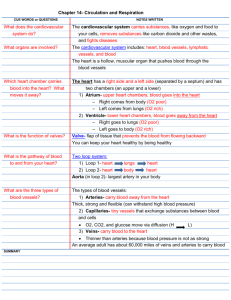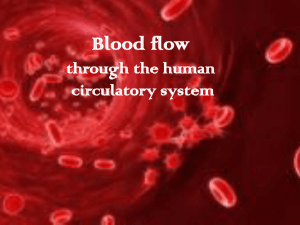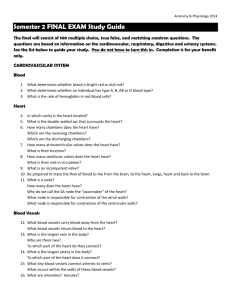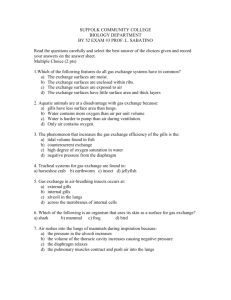Cardiovascular & Respiratory System Review
advertisement
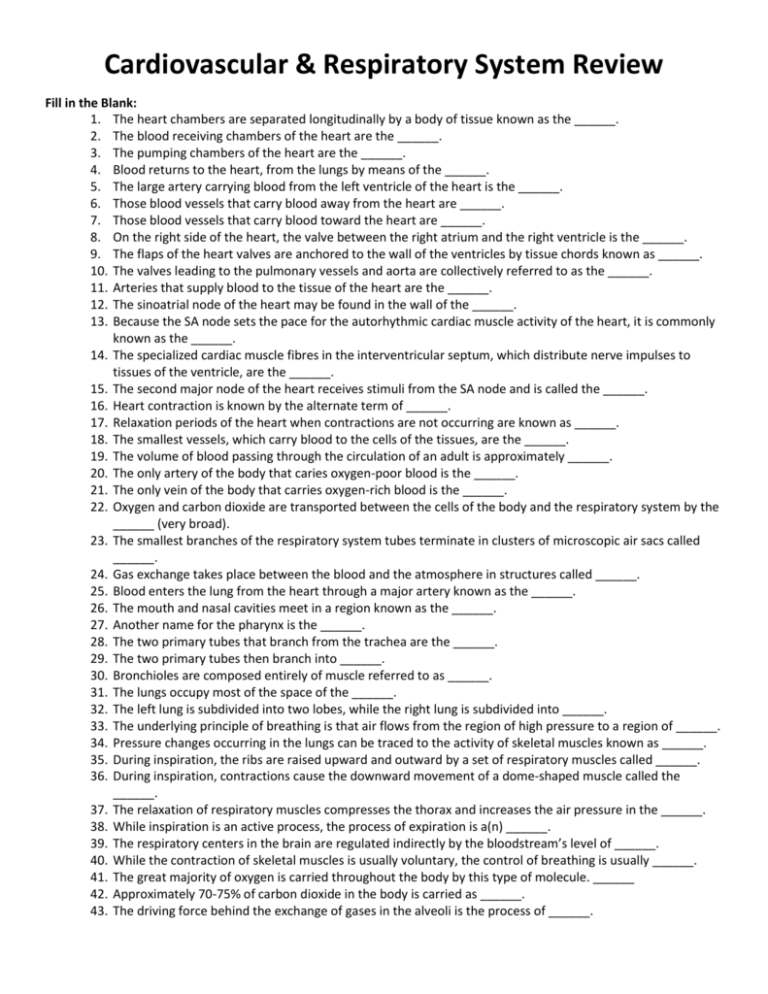
Cardiovascular & Respiratory System Review Fill in the Blank: 1. The heart chambers are separated longitudinally by a body of tissue known as the ______. 2. The blood receiving chambers of the heart are the ______. 3. The pumping chambers of the heart are the ______. 4. Blood returns to the heart, from the lungs by means of the ______. 5. The large artery carrying blood from the left ventricle of the heart is the ______. 6. Those blood vessels that carry blood away from the heart are ______. 7. Those blood vessels that carry blood toward the heart are ______. 8. On the right side of the heart, the valve between the right atrium and the right ventricle is the ______. 9. The flaps of the heart valves are anchored to the wall of the ventricles by tissue chords known as ______. 10. The valves leading to the pulmonary vessels and aorta are collectively referred to as the ______. 11. Arteries that supply blood to the tissue of the heart are the ______. 12. The sinoatrial node of the heart may be found in the wall of the ______. 13. Because the SA node sets the pace for the autorhythmic cardiac muscle activity of the heart, it is commonly known as the ______. 14. The specialized cardiac muscle fibres in the interventricular septum, which distribute nerve impulses to tissues of the ventricle, are the ______. 15. The second major node of the heart receives stimuli from the SA node and is called the ______. 16. Heart contraction is known by the alternate term of ______. 17. Relaxation periods of the heart when contractions are not occurring are known as ______. 18. The smallest vessels, which carry blood to the cells of the tissues, are the ______. 19. The volume of blood passing through the circulation of an adult is approximately ______. 20. The only artery of the body that caries oxygen-poor blood is the ______. 21. The only vein of the body that carries oxygen-rich blood is the ______. 22. Oxygen and carbon dioxide are transported between the cells of the body and the respiratory system by the ______ (very broad). 23. The smallest branches of the respiratory system tubes terminate in clusters of microscopic air sacs called ______. 24. Gas exchange takes place between the blood and the atmosphere in structures called ______. 25. Blood enters the lung from the heart through a major artery known as the ______. 26. The mouth and nasal cavities meet in a region known as the ______. 27. Another name for the pharynx is the ______. 28. The two primary tubes that branch from the trachea are the ______. 29. The two primary tubes then branch into ______. 30. Bronchioles are composed entirely of muscle referred to as ______. 31. The lungs occupy most of the space of the ______. 32. The left lung is subdivided into two lobes, while the right lung is subdivided into ______. 33. The underlying principle of breathing is that air flows from the region of high pressure to a region of ______. 34. Pressure changes occurring in the lungs can be traced to the activity of skeletal muscles known as ______. 35. During inspiration, the ribs are raised upward and outward by a set of respiratory muscles called ______. 36. During inspiration, contractions cause the downward movement of a dome-shaped muscle called the ______. 37. The relaxation of respiratory muscles compresses the thorax and increases the air pressure in the ______. 38. While inspiration is an active process, the process of expiration is a(n) ______. 39. The respiratory centers in the brain are regulated indirectly by the bloodstream’s level of ______. 40. While the contraction of skeletal muscles is usually voluntary, the control of breathing is usually ______. 41. The great majority of oxygen is carried throughout the body by this type of molecule. ______ 42. Approximately 70-75% of carbon dioxide in the body is carried as ______. 43. The driving force behind the exchange of gases in the alveoli is the process of ______. True or False (if the statement is FALSE, change the underlines word to make the statement true): 44. The two inferior chambers of the heart are known as the atria. 45. Blood returns from the body through the superior and inferior vena cava, which empty into the left atrium. 46. Blood moves toward the lungs after it leaves the right ventricle. 47. The aorta, the largest artery in the body, receives blood from the right ventricle. 48. The tricuspid valve lies between the left atrium and the left ventricle. 49. The valves found at the entrance to the pulmonary artery and the aorta are known as semilunar. 50. The atrioventricular valves prevent blood from flowing backward into the ventricles. 51. Impulses for the contraction of heart muscles are generated initially at the atrioventricular node. 52. Fibres known as Purkinje fibres spread out from the AV node and carry impulses to the ventricles. 53. The relaxation period between heart contractions is correctly known as systole. 54. The smallest heart vessels in the human body are known as venules. 55. The only artery that carries carbon dioxide-rich blood is the pulmonary artery. 56. The alveoli are formed of delicate elastic membranes covered by an extensive capillary network, which is part of systemic circulation. 57. The vocal chords, which function in the production of sound, are located within the trachea. 58. The bronchioles are composed entirely of skeletal muscle supported by connective tissue 59. Expansion of the lungs is due, in part, to contractions taking place in the diaphragm muscle. 60. During the process of expiration, the respiratory muscles undergo contraction, and the thoracic cage returns to its original shape. 61. The least amount of carbon dioxide is transported in the blood as bicarbonate ions. 62. The passive process known as osmosis accounts for the movement of oxygen and carbon dioxide gas across the capillary membranes of alveoli. 63. For transport to the body’s cells, oxygen molecules bind loosely to hemoglobin molecules contained in red blood cells. 64. As they leave the area of the alveoli, capillaries join together to form pulmonary venules. Short Answers 65. Define the following terms: Blood Pressure, Heart Rate, Cardiac Output, Strove Volume, A-V O₂ Difference. 66. What is the difference between systolic and diastolic? 67. How is oxygen transported throughout our body? Be specific. 68. What are the three methods used to transport CO₂ throughout our body? Which method is used most? 69. What vessels take blood away from the heart? Towards the heart? 70. Starting with the aorta, what are the next three vessels the blood travels through before reaching your tissue? 71. Starting at the tissue what are the three vessels that your blood travels through before reaching your vena cava? 72. What is VO₂ max and how does it relate to your aerobic, cardiovascular and respiratory system? 73. Differentiate between the bicuspid, tricuspid, aortic semi-lunar and pulmonary semi-lunar valves. 74. Explain why the direction that each heart chamber contracts is important. 75. Explain the electrical conduction system of the heart, beginning with the Sino-Atrial Node and finishing with the Purkinje Fibres. 76. What are the four benefits to you cardiorespiratocy system, acquired from training? 77. What internal structure connects your oral and nasal cavities to your trachea? 78. Put the following terms in order from superior to inferior: bronchioles, bronchi, trachea, larynx, oral/nasal cavity, pharynx, alveoli 79. What is the difference between the conduction and respiration zone? 80. Gas exchange occurs via _____, which is a movement of molecules from a higher to lower concentration. 81. What two primary molecules are we concerned about during respiration? 82. Ventilation involves the movement of air into and out of the lungs, otherwise known as _____ & _____. 83. The movement of air into our lungs is primarily facilitated by these two muscles. 84. When breathing air in, what is the pressure difference between your lungs and outside? 85. When breathing out, what is the pressure difference between your lungs and outside?
